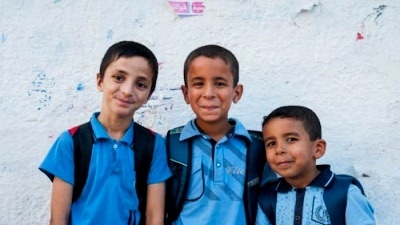Challenge
The continuing volatility of the political and security situation in the West Bank and Gaza (WB&G) was a tremendous challenge. Tight restrictions on movements of people and goods between the West Bank and Gaza because of the closures imposed by Israel contributed to a fragmentation of the Palestinian economic space, depriving many Palestinians of their livelihoods. In early 2006, Israel made the decision to suspend the transfer of domestic Palestinian tax and other revenues that it collected on behalf of the Palestinian Authority (PA). This led to a severe fiscal crisis that undermined public institutions and the delivery of essential public services by the PA. Insufficient domestic revenues squeezed operating budgets, leaving limited resources for these services and periodic work stoppages by staff that were not paid their salaries contributed to disruptions and declines in the provision of health, education, and social welfare services.
Solution
The ESSP MDTF was a pure emergency operation with a focus on project outputs, to maintain essential operation of public education, health, social care and utility facilities. The design of the ESSP MDTF was informed by the lessons learned from the implementation of the previous ESSPs. However, under the ESSP MDTF, donors pooled their resources in a single trust fund, the Multi-Donor Trust Fund (MDTF). The Bank provided no resources to the Fund, but instead acted as Fund administrator. Each donor entered into an administration agreement (AA) with the Bank, and then the Bank entered into grant agreements with the PA. The establishment of a single trust fund reduced transaction costs for the PA and donors. Supervision responsibility for implementation rested solely with the Bank.
Results
The assistance provided through the ESSP MDTF not only prevented a deterioration of education, health, social and public utility services in the Palestinian territories, but it also supported some expansion of service delivery despite the very difficult context. With one exception, project targets were met or exceeded and, at the conclusion of the project, facilities continued to operate at the same or higher levels than the 2007 baselines. Examples include:
- The number of public primary schools operating in 2011 (1,155) is 19 percent higher than the 2007 baseline (972), and the number of students per school (542) in 2011 is 36 percent higher than the 2007 baseline (400).
- In nine universities, the number of academic staff supported by the project in 2011 (3,209) is the same as the 2010 baseline, and the number of students in 2011 (132,750) is 8 percent higher than the 2010 baseline (123,429).
- Social services provided by MOSA facilities witnessed increases in the number of beneficiaries in 2011 compared to 2007, including the number of students in training centers (from 1,300 to 1,600), and the number of youth in youth centers (from 125 to 413).
An important achievement of the project is that the ESSP mechanism is now considered a Palestinian-administered mechanism that can be scaled up or downwards to fund recurrent expenditures for social sector ministries.
Bank Group Contribution
The Bank did not make any financial contribution to the ESSP MDTF, which was financed entirely by donors. Over the five-year project period, the Bank’s incremental costs (staff time, benefits, travel and consultants) of administering the ESSP MDTF on the donors’ behalf amounted to US$1.13 million. A customized fee structure was designed to enable the Bank to recover from donors all those incremental costs; the fee was paid by the donors in proportion to their contribution to the overall MDTF budget.
Partners
The European Commission and ten individual countries (Australia, Austria, Belgium, France, Italy, Norway, Spain, Sweden, Switzerland and the United Kingdom) financed the ESSP MDTF. In the following table, donor contributions in their own currencies have been converted into U.S. dollars equivalent based on the exchange rates on the dates their contributions were received by the Bank. Over the five-year project period, donor contributions totaled US$88.04 million equivalent, as follows:
Donor |
Currency and amounts |
US$ equivalent (million) |
European Commission |
Euro 20,000,000 |
27.44 |
Spain |
Euro 15,000,000 |
19.50 |
United Kingdom |
pounds sterling 6,000,000 |
11.38 |
Sweden |
Swedish krona 45,000,000 |
6.53 |
Switzerland |
U.S. dollar 4,300,000 |
4.30 |
France |
Euro 3,000,000 |
3.98 |
Australia |
Australian dollar 4,000,000 |
3.60 |
Norway |
Norwegian kroner 21,696,711 |
3.53 |
Belgium |
Euro 2,500,000 |
3.28 |
Italy |
Euro 2,277,000 |
3.24 |
Austria |
Euro 1,000,000 |
1.26 |
Total |
|
88.04 |
Moving Forward
With the closing of both the ESSP MDTF and the ESSP III, emergency-type budget support to help the PA provide basic social services will continue to be needed in the short- and medium-term, particularly given the serious fiscal crisis being faced by the PA.
Beneficiaries
Direct beneficiaries included: the Ministry of Education and Higher Education (MOEHE), the Ministry of Health MOH), the Ministry of Social Affairs (MOSA), the Coastal Municipalities Water Utility (CMWU), the Palestinian Water Authority (PWA), and the Palestinian Energy Authority (PEA). The entire Palestinian population in both the West Bank and Gaza benefited from the project. Overall, 52 percent of the funds were allocated to health services, 36 percent to education services, 10 percent to public utilities, 1 percent to social welfare and 1 percent to project management and monitoring. By supporting the operation of public primary schools and health facilities, the project benefited, to a large extent, the poorer segments of the Palestinian population.
